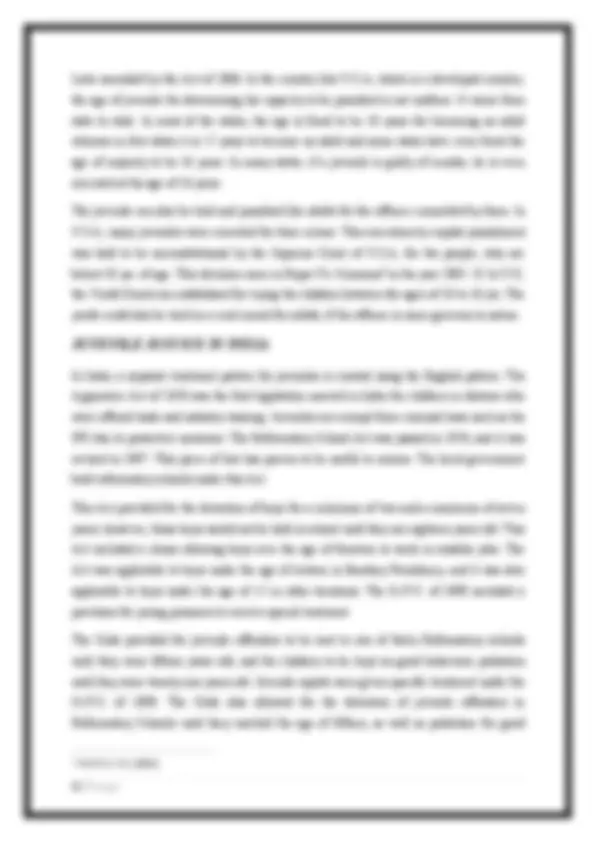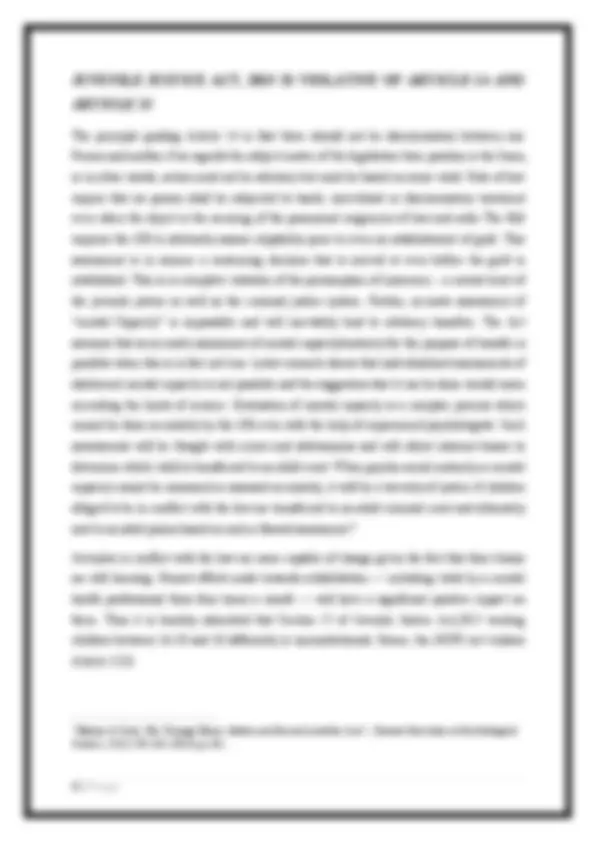





Study with the several resources on Docsity

Earn points by helping other students or get them with a premium plan


Prepare for your exams
Study with the several resources on Docsity

Earn points to download
Earn points by helping other students or get them with a premium plan
Community
Ask the community for help and clear up your study doubts
Discover the best universities in your country according to Docsity users
Free resources
Download our free guides on studying techniques, anxiety management strategies, and thesis advice from Docsity tutors
Children are the country's most valuable asset and resource. Children should be allowed and given the opportunity to develop into strong people who are physically fit, emotionally alert, and morally healthy, with the skills and activation that society requires. Equal opportunities for development should be afforded to all children during their growth period in order to reduce inequalities and ensure social justice, which would then serve as an effective tool to reduce juvenile delinquency. Child
Typology: Summaries
1 / 6

This page cannot be seen from the preview
Don't miss anything!




Guided by: Swati Mohapatra Prepared by: Shivam Sourav Mallick (1983118)
Children are the country's most valuable asset and resource. Children should be allowed and given the opportunity to develop into strong people who are physically fit, emotionally alert, and morally healthy, with the skills and activation that society requires. Equal opportunities for development should be afforded to all children during their growth period in order to reduce inequalities and ensure social justice, which would then serve as an effective tool to reduce juvenile delinquency. Children should be obedient, polite, and imbued with virtues and good qualities. Children do not follow established social and legal dictum for a variety of reasons. In recent years, it has become abundantly clear that juvenile delinquency is the most important component of the criminology topic. In recent years, there has been a push for a more objective assessment of the issue as well as the development of new approaches. Juvenile delinquency has taken on more serious forms, which is a sign of a sick society. The global phenomenon of disorder and destruction caused by deviant behaviour is reaching disturbing proportions in social groups, serving as a wake-up call to those who are either in its grip or are about to be struck. After the Delhi Gang Rape in 20121 , it was discovered that one of the defendants was just a few months away from turning 18. As a result, he was prosecuted in a juvenile court. Subramanian Swami, a BJP politician, filed a Public Interest Litigation in the Supreme Court of India on July 31, 2013, requesting that the boy be tried as an adult. The Court requested that the juvenile court postpone its decision. (^1) Mukesh v. State (NCT of Delhi) [(2017) 6 SCC 1]
Juvenile law's history Pope Clement XI was concerned about separate institutional treatment for juvenile offenders, so he established an institutional treatment for juvenile offenders in
In Country like France, the treatment system for punishing child is divided as per the age group of child. In this country a child till 10 yrs. of age, cannot be termed as criminal and even not be charged for the same. Those Children who are between 10 to 13 yrs. of age, if found committing any crime, then they were to be punished only by keeping them in a specialized home or centre. However, if a child is between the age of 16 to 18 yrs., commits a crime, then he cannot take the defence of his juvenility and the person will be sent to a criminal court. Later on due to the changes in the concept and in the view of current Juvenile justice system, brought out by the Beijing rules and the CRC, The J.J (C & P of C) Act 2000 was passed.
behaviour until they reached the age of twenty-one. Following this, the presidents and provinces passed Indian Children Acts. These statutes included provisions for creating a special mechanism for dealing with juveniles. In 1919-20, the Indian Jail Committee made recommendations for a robust legislature to ensure that children's rights and protection were realised. Following independence, the Government of India passed the Children Act of 1960. The legislation was in effect in all Union Territories, but states were not required to follow it. As a result, India's juvenile justice system was not standardised. When the JJ Act 1986 was enacted, this was abolished. The legislation was expanded to cover the entire country. In India, the definition of child is very clear, that includes a person under the age of 18 years. But when time comes to apply it for a crime committed by child, then the case is not the same. The principle of Doli Incapax , completely exclude child under 7 years of age from liability for crime. Children are being protected from criminal prosecution on the pretext of being very young to understand the consequences of the acts committed by him. In country like India, it is a need of hour to get reforms done in the laws of juvenile. There is a tremendous increase in the crime rates committed by juvenile. The juveniles are easily escaping punishments, because the laws in India protect them.
In 2012, in Delhi the brutal gang rape of a paramedic student named Jyoti Pande " Nirbhaya "^3 in a moving bus where a Juvenile was also a member of the ghastly assembly. and open investigation it was found out that he was the cruellest perpetrator and because of his age treated leniently under the scheme of Juvenile justice act, 2000. Hence, The Juvenile Justice Act, 2015 contains the objective to make no departures from the protective approach of juvenile justice towards the children below the age of 18 in conflict with law and also those who need case and protection. According to act 2015 children between the age of sixteen and eighteen can be tried as an adult depending upon the heinousness of the crime committed. Now the very question is what is heinous and what is not. Thus this imparts a power on the Board which is completely arbitrary in Nature as the board may choose to take assistance at its own will. A common man or lay person is not qualified to assess the mental capacity of a juvenile and therefore the assistance of experienced psychologists or psycho-social workers or other experts is extremely crucial in assessing the mental capacity of a juvenile. (^3) Mukesh v. State (NCT of Delhi) [(2017) 6 SCC 1]
The principle guiding Article 14 is that there should not be discrimination between one Person and another if as regards the subject matter of the legislation their position is the Same, or in other words, action must not be arbitrary but must be based on some valid. Rule of law require that no person shall be subjected to harsh, uncivilized or discriminatory treatment even when the object is the securing of the paramount exigencies of law and order The Bill requires the JJB to arbitrarily assess culpability prior to even an establishment of guilt. This assessment is in essence a sentencing decision that is arrived at even before the guilt is established. This is in complete violation of the presumption of innocence - a central tenet of the juvenile justice as well as the criminal justice system. Further, accurate assessment of “mental Capacity” is impossible and will inevitably lead to arbitrary transfers. The Act assumes that an accurate assessment of mental capacity/maturity for the purpose of transfer is possible when this is in fact not true. Latest research shows that individualized assessments of adolescent mental capacity is not possible and the suggestion that it can be done would mean exceeding the limits of science. Evaluation of mental capacity is a complex process which cannot be done accurately by the JJB even with the help of experienced psychologists. Such assessments will be fraught with errors and arbitrariness and will allow inherent biases to determine which child is transferred to an adult court. When psycho-social maturity or mental capacity cannot be measured or assessed accurately, it will be a travesty of justice if children alleged to be in conflict with the law are transferred to an adult criminal court and ultimately sent to an adult prison based on such a flawed assessment.^4 Juveniles in conflict with the law are more capable of change given the fact that their brains are still learning. Honest efforts made towards rehabilitation — including visits by a mental health professional three-four times a month — will have a significant positive impact on them. Thus it is humbly submitted that Section 15 of Juvenile Justice Act,2015 treating children between 16-18 and 18 differently is unconstitutional. Hence, the JJCPC act violates Article 15(3). (^4) Bonnie & Scott, The Teenage Brain: Adolescent Research and the Law ‘, Current Directions in Psychological Science, 22(2) 158 – 161 (2013), p.161.